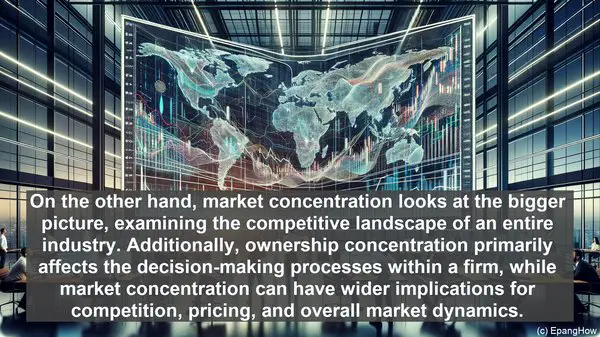Introduction: The Significance of Concentration
Hello everyone! In the intricate world of business and economics, the notion of concentration holds immense importance. It not only shapes the dynamics of markets but also influences the overall structure of industries. Today, we’re going to explore two crucial aspects of concentration: ownership concentration and market concentration. While they might sound similar, they actually refer to distinct phenomena. So, let’s dive in!

Ownership Concentration: A Closer Look
Ownership concentration, as the term suggests, pertains to the distribution of ownership within a company. It essentially measures the extent to which a firm’s shares are held by a select group of individuals or entities. In other words, it gauges the level of control exercised by a specific set of stakeholders. High ownership concentration implies that a small group has a significant say in the company’s decision-making processes. This can manifest in the form of majority shareholders or dominant family ownership.
Market Concentration: Understanding the Landscape
On the other hand, market concentration focuses on the structure of an entire market or industry. It gauges the degree to which a market is dominated by a few key players. This is often measured through metrics like the concentration ratio or the Herfindahl-Hirschman Index (HHI). A highly concentrated market is one where a handful of firms hold a substantial market share, potentially leading to reduced competition and increased barriers to entry for new players.
Key Differences: Ownership vs. Market Concentration
While both ownership concentration and market concentration revolve around the idea of concentration, their key distinctions lie in their scope and implications. Ownership concentration is internal to a company, focusing on the distribution of control within its confines. On the other hand, market concentration looks at the bigger picture, examining the competitive landscape of an entire industry. Additionally, ownership concentration primarily affects the decision-making processes within a firm, while market concentration can have wider implications for competition, pricing, and overall market dynamics.

Implications: The Ripple Effects
The implications of ownership concentration and market concentration are far-reaching. In the case of ownership concentration, it can lead to a more streamlined decision-making process, as a select group can swiftly implement changes. However, it can also result in a lack of diversity in perspectives and potential conflicts of interest. Market concentration, on the other hand, can impact competition. A highly concentrated market may witness reduced competitive pressures, potentially leading to higher prices for consumers and limited choices. It can also pose challenges for new entrants, making it harder for them to establish a foothold.
